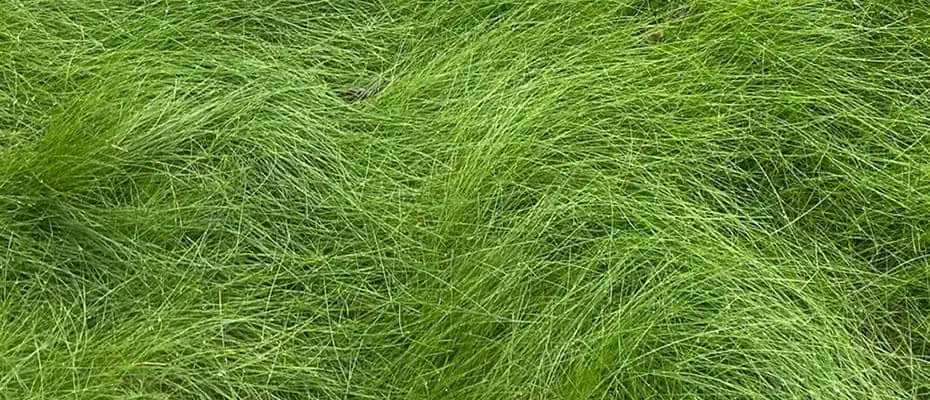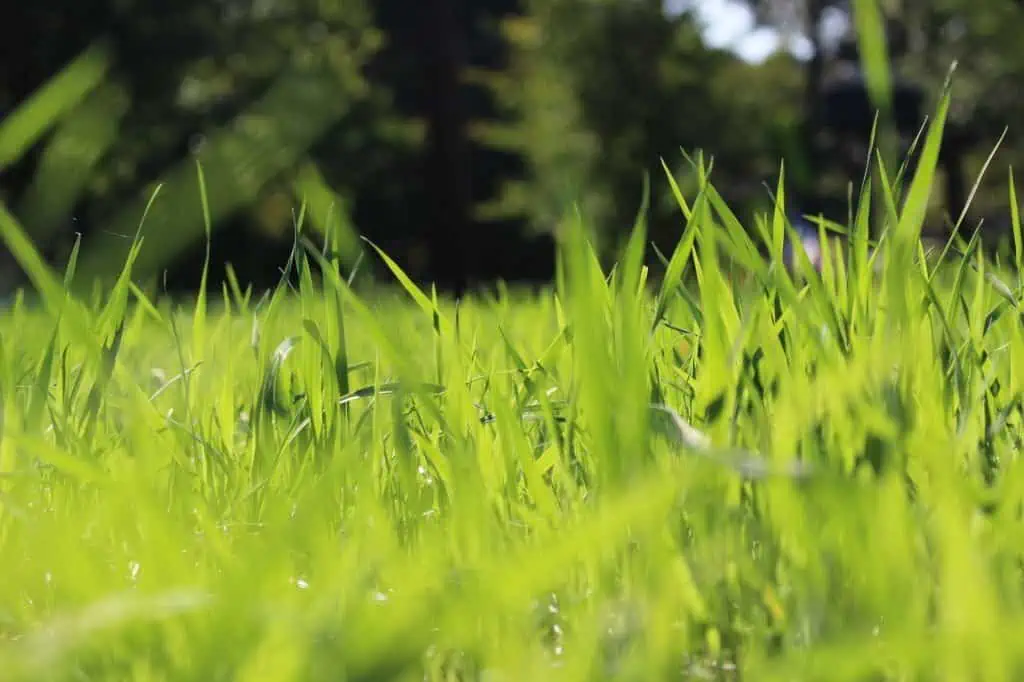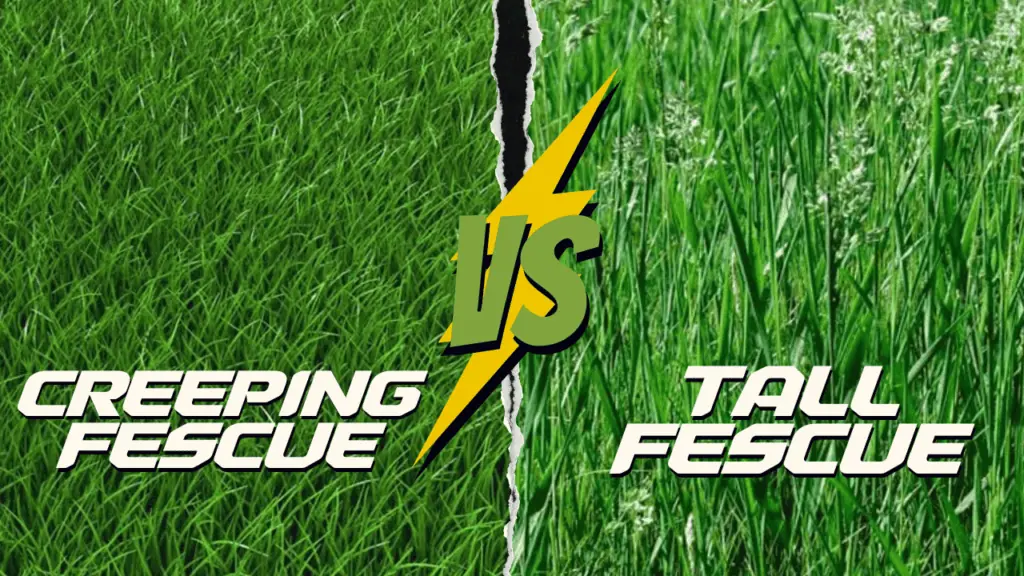Fescues are among your best bet if you want a lawn with low maintenance requirements. Many fescues exist, but tall and creeping reds are among the most popular. Both originated in Europe, but they’re widely used for lawns in the US today.
They have characteristics similar to most other fescue types but also have some distinct ones. Therefore, conducting some research before buying any of them is advised.
This article will compare both grass types to help you make an informed decision. You’ll understand the pros and cons of each of them and which is best for your application.
What is Creeping Red Fescue?
There are five types of fine fescues, and creeping red fescue is one of them. This grass type is popular in the Northwestern area of the US because the environment best supports its growth. You can identify the grass type with its thin, white, hair-like blades with a creeping growth habit.
It’s one of the simplest grass types to grow and has low maintenance requirements. They have moderate to high drought tolerance and thrive under shady conditions. Creeping red fine fescues needs a soil PH of around 5.5-6.5 inches, under which it can grow up to 6-12 inches if you don’t mow it.
That said, here are some pros and cons of the grass type.
Advantages of Creeping Red Fescue

It’s Resistant to Drought, Heat, and Cold
Creeping red fine fescue is known for its high drought tolerance. You can leave it for a long time without watering it, and the grass will still respond fine once you resume the process. It can also withstand the harsh weather of winter. Irrespective of the season, it’ll germinate well if you maintain it.
It Has Low Maintenance Requirements
Whether it’s mowing or watering, creeping red fescues are known to have one of the lowest maintenance requirements among all types of lawn grasses. You can even leave the lawn for a no-mow look if you want. They don’t grow straight like tall fescues and can stay for long periods with a mow.
As for watering, once a month is the standard. This low watering requirement is due to the grass’s excellent moisture-retaining characteristic. It’s deeply rooted underground and can store water to sustain itself.
Creeping red fescues also has low fertilizing requirements. Annually, it only needs a comparatively small Nitrogen amount as with other grasses. Beware of overfertilizing as it can cause the grasses to overgrow.
It Can Thrive on Infertile, Sandy Soil
Few grasses can grow on poor, infertile soil, and creeping red fescue is one of them. It’s one of your best options if you live in an area with poor soil. Creeping red is also decent for overseeding because it mixes well with other grasses.
Disadvantages of Creeping Red Fescue
The moisture retention quality of creeping red fescue can also be one of its most significant disadvantages. If you live in an area with high rainfall or your lawn holds puddles, creeping red fescue can cause waterlogging.
When the grass gets too much water, it can get infected with pests and fungal infections. You should avoid exposing them to too much water as much as possible.
Creeping red fescue is heat tolerant, but it doesn’t mean they can’t get brown patches in the summer. They tend to go dormant and revive when the cool season comes around. If you want a green yard all year round or you live in an area with a predominantly dry climate, creeping red fescues isn’t for you.
Creeping red fescue doesn’t have a good traffic tolerance. You might need to reconsider planting it if you have kids around or live where people will step on it.
Depending on how you love to care for your lawn, you might not enjoy creeping red fescue. The reason is that although it germinates quickly, it invests this quick germination feature into spreading rather than height. You might not appreciate a lawn full of creeping red fescue if you enjoy cutting your grasses frequently.
What is Tall Fescue?
Tall fescue is popular in the Pacific Northwest to the Southwestern areas of the US. Unlike fine fescue, it has broad and coarse leaves that grow tall, hence the name. It also has a bunch-type growth.
Tall fescues are known for their adaptability to the transition areas of the US. These areas are too hot for warm-season grasses and cold for cool-season ones. They also perform well in almost all conditions and tolerate many climates.

Advantages of Tall Fescue
Let’s identify some advantages of the grass type.
- It Can Tolerate Heat and Drought: As mentioned earlier, one of the advantages of tall fescue is its tolerance to heat and drought. It can stay for up to two weeks without water and maintain its fresh look.
- It Can Tolerate Shade: Like creeping red fescue, this grass can thrive under the shade while maintaining the same appearance as in a sunny area.
- It Can Handle Foot Traffic: Tall fescue can handle moderate foot traffic, making them suited for a home with kids. Their leaves are strong and resilient. As much as it’s traffic tolerant, be careful when walking barefoot, especially with children. Its coarse and rough-textured nature can hurt their foot or cause discomfort when they sit on it.
- It Germinates Quickly: Tall fescues seeds are known to start sprouting after two weeks you plant them. It will germinate quicker if you’re reseeding.
That concludes the advantages of tall fescues; the following section will educate you on some disadvantages.
Disadvantages of Tall Fescue
If you want to plant tall fescue, understand that you must maintain it regularly, especially from March to October. The grass is usually at its best during this period and would need frequent mowing to ensure consistency. It isn’t a decent option if you would prefer a no-mow lawn.
As much as it’s drought tolerant, you need to understand that it can’t tolerate a long period of drought. It would begin to show signs of dehydration if you didn’t water it for two weeks.
Tall fescues are also one of those grasses that you want to avoid watering excessively. The risk of getting infected with diseases increases when exposed to moist conditions. Maintain the recommended watering schedule when working with tall fescues.
It’s also imperative to note tall fescues are notorious for their invasiveness. When these grass types start sending out their rhizomes, they can be problematic for native vegetation around. If you have other plants that you would love to protect, it would be in their best interest to keep tall fescues out of the equation.
Which Grass is Better?
Creeping red fescue and tall fescue have many similarities and differences. Both types of grass can tolerate both heat, cold, and drought. They can both tolerate shade, although fine fescue has a better tolerance.
The one that’s best for you depends on your application. You should opt for creeping red if low maintenance appeals to you. If you have kids who would love to spend their evenings in the yard, a creeping red is not your best option.
If price matters in your choice-making, creeping red is slightly more expensive than tall fescue. A pound of creeping red fescue can sell for around $3-$8, while tall fescue is between $3-$7. Both grass types cost higher if you want to buy sod, plugs, or cuttings.
Conclusion
Tall and creeping red fescues are perfect on their right, and it’s all about which one is right for your application. Creeping red fescue has a low maintenance requirement, while tall fescues have a better traffic tolerance. They’re all okay for different climatic conditions, although creeping red works in dry conditions better.
No matter the grass type you buy, ensure you follow the correct planting requirements and care for them well. If you grow them under the best conditions, they can grow to become the grass you cherish.






